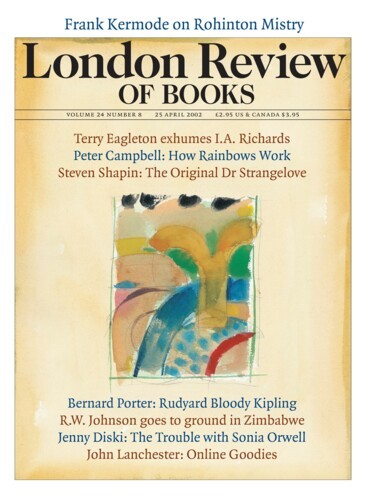Living as we do in the Land of the League Table, there’s sadly little call to be surprised by the appearance of what some will see as a prosopographical breakthrough: a book confidently entitled The Most Evil Men and Women in History (Michael O’Mara, £15.99) and with a cover where the word ‘evil’ appears in black in a type size several magnitudes greater than that of its supporting syntax. Nor should we be surprised for a second time to find that this is a set of potted life-stories to go with a ten-week television series that has just got under way on Channel 5. The 15 historical figures selected to make up what it would be comforting to believe was literally a cast list from hell are no doubt the sediment left behind from a more extensive list of candidates following hours of strenuous haggling as the programme planners argued for their favourites: ‘OK, I’ll give you Attila the Hun if you’ll let me have Vlad the Impaler.’ Disappointingly, viewers aren’t being asked to work their way up, in reverse order of nastiness, starting with the men and women who were only fairly evil to those who were very evil indeed, with the most evil of all left till last. Rather, the series is tamely chronological, kicking off with Caligula (‘The Schizophrenic Emperor’, which you’d have thought might let him off the hook) and ending with the one living evildoer, Idi Amin (‘The Butcher of East Africa’). As for the three women who were reckoned bad enough to qualify, ‘Bloody Mary’ (‘A Catholic Queen in a Protestant Country’, I mean . . .), Elizabeth Countess Barthory (‘Countess Dracula’) and Ilse Koch (‘The Bitch of Buchenwald’), their presence owes more to the Equal Opportunities Commission than to anything they actually did. What with one thing or another, the word ‘evil’ has never had it so good: according to the latest Harper’s, it got five mentions in Bush the Younger’s one State of the Union address (Clinton got round to it only twice in all of his), and if comparatism of the Channel 5 kind takes a hold, it won’t be long before an enterprising college takes a leaf out of Don DeLillo’s delightful White Noise and offers an undergraduate course in Evil Studies.
Meanwhile, any teacher looking for a premier league example of a metonym to wow the class with might do worse than choose the world’s most photogenic mailbox: that which sits beside what looks like a suitably unmade-up road somewhere in New England with the name ‘Salinger’ stencilled on its scored and rusty flank. For close on forty years now, this weathered receptacle has been asked to stand in for the man whose mailbox it is, who has himself passed definitively from view in a sustained fit of unsociability such that you wonder whether the mailbox may not be a blind, put up outside someone else’s house in the hope of siphoning off unwanted communications from the outside world. Its latest appearance is as the jacket photograph on an odd compilation called Letters to J.D. Salinger (Wisconsin, £20.95), in which a large number of the writer’s fans address their thoughts and questions to him, not in the expectation that he will ever read, let alone answer what they have to say but simply for the pleasure of participating in this Postmodern version of a Festschrift. The cheery individual who thought up the volume, Chris Kubica, says that he spent five years getting the contributions together after discovering what a lot of www activity there was in respect of ‘old J.D.’ and his much-loved novel, on the arcane and desperate lines of ‘Let’s talk about the symbolism of the gloves in CITR. SOMEONE PLEASE REPLY!!!!!’ Kubica admits that back in the days when a pilgrim’s life attracted him more than it does now, he thought he might go and call on Salinger in person, but he was put off by reading all those articles ‘about people writing to Salinger or trying to see and talk to him in person and how he got upset and sometimes semi-violent toward them’. So, not wishing to have semi-violence done towards him, he decided to creep up on his combustible subject by what he calls the ‘back door’. Well, at least letters written to J.D. Salinger don’t run the risk of suffering the fate of those written by him, which, as readers of the obituaries and of his conversations with Dan Jacobson in this paper will recall, cost the late Ian Hamilton much grief when he tried to quote them verbatim in his biography and was taken to court. Salinger wasn’t having any, and you have to wonder whether the old curmudgeon deserves even a backdoor tribute like Kubica’s.
Send Letters To:
The Editor
London Review of Books,
28 Little Russell Street
London, WC1A 2HN
letters@lrb.co.uk
Please include name, address, and a telephone number.

